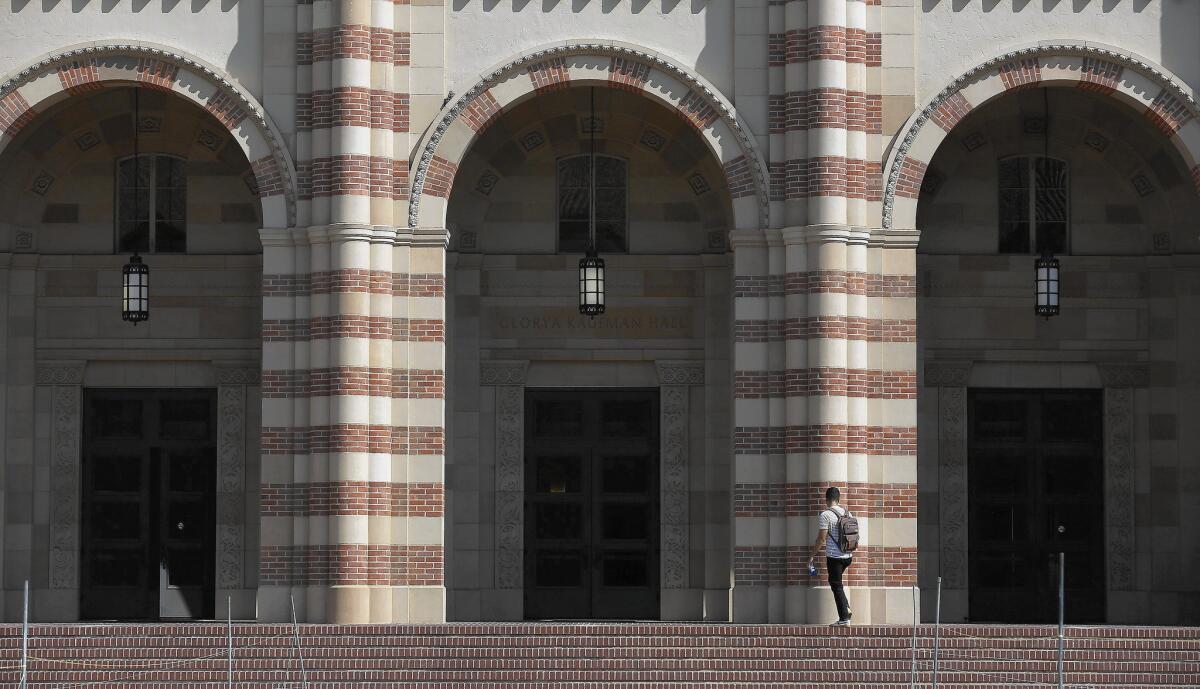UC regents approve plan to add 10,000 in-state undergraduate students by 2018

- Share via
Reporting from SAN FRANCISCO — UC regents on Thursday unanimously approved a plan to increase enrollment of California undergraduates at UC by 5,000 next fall and an additional 5,000 by 2018, despite concerns over whether the university will be able to hire enough professors and provide enough dorm space.
UC officials said they feel certain that the student growth can be accommodated without too many problems, even if that means hiring more temporary lecturers while permanent new faculty are vetted and that more students may be placed in triple dorm rooms.
Some of the hiring of what may be about 500 faculty over the next two years “is well underway,” said Nathan Brostrom, UC executive vice president and chief financial officer. But while he acknowledged that “a lot of work is ahead,” particularly with adding classrooms and housing, he said he thought it could be managed.
Several regents said they were worried about possible overcrowding in classes and housing and insufficient services such as mental health counseling. Student regent Abraham “Avi” Oved, a UCLA student, said he feared “an erosion of educational opportunities” in the short run, particularly next year.
“Where are we going to put them?” he asked about the extra students.
Yet Oved joined all other regents in supporting the plan, he said, as a symbolic vote of confidence that UC President Janet Napolitano and other officials would do their best to manage the growth.
Napolitano’s plan for enrollment increases is in part a response to criticism from legislators and parents that UC had added too many students from other states and nations for the higher tuition those students pay. The Legislature last spring allocated an additional $25 million to UC to increase the number of in-state undergraduates by 5,000 no later than 2016-17. UC will seek extra state money for the following years.
Under the plan, in-state enrollment of freshmen and transfer students will rise by 5,000 next fall and then 2,500 more in each of the two following school years. The 10,000-student increase would represent a boost of about 20% over the nearly 50,000 new in-state freshmen and transfer students who enrolled this fall.
Also, an additional 2,000 graduate students would be added by 2018.
The much-criticized increases in undergraduates from outside California would continue but at a slower pace.
Some of the funding would come from phasing out UC and state aid for low-income students from outside the state. Current students will be able to keep their aid until graduation but new ones will not receive any UC grants, although they will remain eligible for federal aid and private scholarships. Some student activists oppose that change, saying that only affluent students from outside California will be able to attend UC.
UC officials on Thursday did not offer details on how many extra students each campus will take, saying that will take more study over the next couple of months. All nine undergraduate campuses will be assigned significant amounts, they said.
Also on Thursday, regents approved a long-brewing plan to expand UC Merced by constructing new classrooms, dorms and labs over the next five years and boost enrollment there by nearly 4,000 more students.
The $1.14-billion proposal to double UC Merced’s physical capacity is unusual since a single master developer will be chosen to oversee the design, building and long-term maintenance of the project. In response to regents’ past concerns that the university might face too much financial risk, the plan was changed recently to require more direct investment by the developer and other measures to better protect the university.
UC Merced, the youngest of UC’s10 campuses, opened in 2005 and now enrolls about 6,600 students on its San Joaquin Valley campus. But its growth has been hampered by financial problems since the recession and environmental issues on its vast acreage.
UC Merced Chancellor Dorothy Leland said Thursday that the plan is “really about the future of the University of California and its ability to continue to provide access to the poorest region of the state and to an incredibly deserving and diverse population.”
She added that Thursday’s vote was a piece of good news after a difficult period, referring to the trauma this month when a male student stabbed four people on campus and then was shot dead by police.
About 919,000 square feet of new space is expected to be built by 2020. Over time, the UC system will use a portion of its annual state funding to pay back $400 million it is borrowing for the project over 40 years and the campus itself will pay $137 million. Much of the rest will be financed by borrowing and direct investment by the developer, officials said.
Earlier in the day, Merced Mayor Stan Thurston and other Merced community leaders urged the regents to approve the expansion, pledging cooperation with UC and predicting that it would benefit students and families in the region.
[email protected]
Twitter:@larrygordonlat
ALSO:
Israeli spy Jonathan Pollard released from U.S. prison after 30 years
Gunmen attack hotel in Mali’s capital, take 170 hostages
House votes to block Syrian refugees despite White House veto threat
More to Read
Sign up for Essential California
The most important California stories and recommendations in your inbox every morning.
You may occasionally receive promotional content from the Los Angeles Times.











